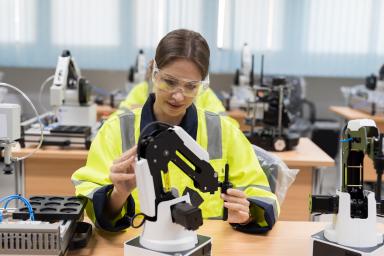Sustainability in the workplace
Looking to create a more sustainable start-up?
The devastating effects of climate change impact every one of us, and the drive to sustainable living and working is becoming an important part of starting and running a business.
Customers are increasingly looking at a business's green credentials when buying, and future legislation is likely to increase the pressure on businesses to adopt sustainable working practices.
Interest in sustainable businesses is partly being driven by COP26.
This year's conference, held in Glasgow, is focused on the actions required to combat climate change and limit global temperature rises to 1.5 degrees by halving global emissions of greenhouse gases by 2030.
The UK has pledged to make the nation net-zero by 2050, something only achievable with major societal, industrial and cultural change.
Businesses will need to play a major part in lowering emissions, as UK businesses account for over 15% of the UK's greenhouse gas emissions.
Start-ups can be more sustainable through reduced energy consumption, as well as making greener choices in workplaces and in their supply chain.
In this first part of our guide to creating a sustainable start-up, we've collected ideas and inspiration to make your workplace and premises more sustainable - from tips on lowering energy consumption to choosing sustainable suppliers.
Find out more about how to make your day-to-day business activities more sustainable in part two, and learn how to nudge staff behaviours towards more sustainable working in part three.
Ten ways to create a more sustainable workplace
From reducing water usage to sourcing recycled office supplies, here are ten ways you can make your workplace more sustainable.
1. Create an energy-saving strategy
Start by measuring your company's carbon footprint and identifying key areas that need attention.
Using this information, devise an energy-saving strategy with end-of-year goals such as a 20% reduction on your heating bill.
Installing a smart meter is a useful way to monitor your energy usage and adjust your habits accordingly.
2. Consider lighting
Sufficient lighting so that people can work is vital, but with lighting accounting for up to 40% of a company's electricity use, it's a good place to start.
A few small changes can make a real difference in helping to reduce your business's carbon footprint.
Switching to energy-efficient bulbs could be your first step.
The most popular energy-efficient bulbs are light-emitting diodes (LEDs), as these use around 90% less energy than traditional incandescent bulbs and last ten times longer.
Every LED replacing a halogen bulb saves roughly 5kg of C02 emissions and making the switch could cut your energy bill.
Other steps you can take to further boost your company's sustainable lighting score include turning off lights in unused areas such as meeting rooms, storage areas and corridors, or installing a motion-activated lighting system so lights come on only when someone is in the room.
3. Use renewable energy sources
Examine your company's energy sources and explore green alternatives for powering and heating your workspace.
Installing solar panels on the roof could reduce or even replace your fossil-fueled electricity usage and save money in the long term.
There are a number of sustainable heating options to replace gas, including renewable heat pumps and biomass boilers.
The UK's energy sector comprises several green energy suppliers who can power your business using renewable sources.
4. Rent rather than buy office furniture
Furniture manufacturing is an energy-intensive business, with the production of a single item creating 47kg of carbon dioxide equivalents.
Additionally, new pieces require raw materials such as wood and metal which have to be sourced.
Leasing your desks, chairs and filing cabinets saves valuable resources and a considerable amount of energy from the manufacturing and transportation processes.
If you prefer your fixtures to be more permanent, consider buying second-hand items or upscaling old pieces.
5. Keep equipment and machinery up-to-date
While it may get the job done, old machinery and equipment may be using more energy than necessary.
Newer technology can make equipment more energy-efficient, helping you create a more sustainable workplace.
In addition, consider setting up your office with laptops rather than desktops, as the former use up to 80% less energy.
The fact that laptops are mobile also makes it easier for staff to work from home when required, which in turn reduces emissions from their daily commute.
6. Make your workspace more energy efficient
According to the Carbon Trust, activities such as adding draft stripping to doors can reduce heating costs by up to 10%.
It found that around 9% of heat loss is through walls, and over 20% of heat loss is through the roof.
Insulating your workspace prevents heat from escaping and reduces the amount of end-use energy consumed.
Other heat retention initiatives include double glazing, sealing windows and using draft excluders.
7. Reduce the amount of waste
Increasing sustainability is not just about reducing energy consumption; it's about conserving natural resources and protecting global ecosystems.
Limiting the amount of waste we produce reduces the amount sent to landfill, which in 2011 accounted for 3.1% of total greenhouse emissions in the UK.
Further ways to reduce waste include avoiding single-use items such as disposable cups, sugar sachets and paper hand towels.
There are reusable alternatives to most disposable products, such as water glasses, sugar bowls and fabric towels.
A key step for reducing waste is removing all under-desk bins, as these invariably end up filled with items that could be recycled.
8. Reduce water usage
The average office building uses 50 litres of water per person per day, and the effects of climate change mean the world's fresh water supply is becoming increasingly unpredictable.
With toilet flushing accounting for 43% of company water consumption, putting a water displacement bag in your cistern could save a litre of water with every flush.
Other water-saving initiatives include self-closing taps and doing away with office dishwashers.
9. Choose sustainable suppliers
Transportation of raw materials and goods is one of the things which leads to an increase in the overall carbon footprint of your business.
Opting for recycled, sustainably sourced and, where possible, local products reduces your company's wider impact upon the environment.
Selecting recycled printer and toilet paper and refillable printer ink cartridges limits plastic waste and deforestation.
Opting for local service providers, such as independent cleaners and repair workers, supports the local economy and reduces transport emissions.
Discover more about creating a sustainable supply chain.
10. Buy a hot and cold water machine
Drinks fridges and constantly boiling kettles can use a great deal of energy, especially if your company hosts lots of meetings.
Investing in a hot and cold water dispenser removes the need for the former appliances and uses less energy due to their built-in power settings which act on demand.
Learn more about how you might fund your sustainable new business.
Learn with Start Up Loans and help make your business born sustainable.
Thinking of starting a sustainable business? Check out our free online courses in partnership with The Open University on environmental decision-making and how organisations impact the environment.
Our free Learn with Start Up Loans courses include:
Plus free courses on climate and sustainability, teamwork, entrepreneurship, mental health and wellbeing.
Disclaimer: The Start -Up Loans Company makes reasonable efforts to keep the content of this article up to date, but we do not guarantee or warrant (implied or otherwise) that it is current, accurate or complete. This article is intended for general information purposes only and does not constitute advice of any kind, including legal, financial, tax or other professional advice. You should always seek professional or specialist advice or support before doing anything on the basis of the content of this article.
The Start-Up Loans Company is not liable for any loss or damage (foreseeable or not) that may come from relying on this article, whether as a result of our negligence, breach of contract or otherwise. “Loss” includes (but is not limited to) any direct, indirect or consequential loss, loss of income, revenue, benefits, profits, opportunity, anticipated savings, or data. We do not exclude liability for any liability which cannot be excluded or limited under English law. Reference to any person, organisation, business, or event does not constitute an endorsement or recommendation from The Start-Up Loans Company, its parent company British Business Bank plc, or the UK Government.
Your previously read articles
Sign up for our newsletter
Just add your details to receive updates and news from Start Up Loans
Sign up to our newsletter


